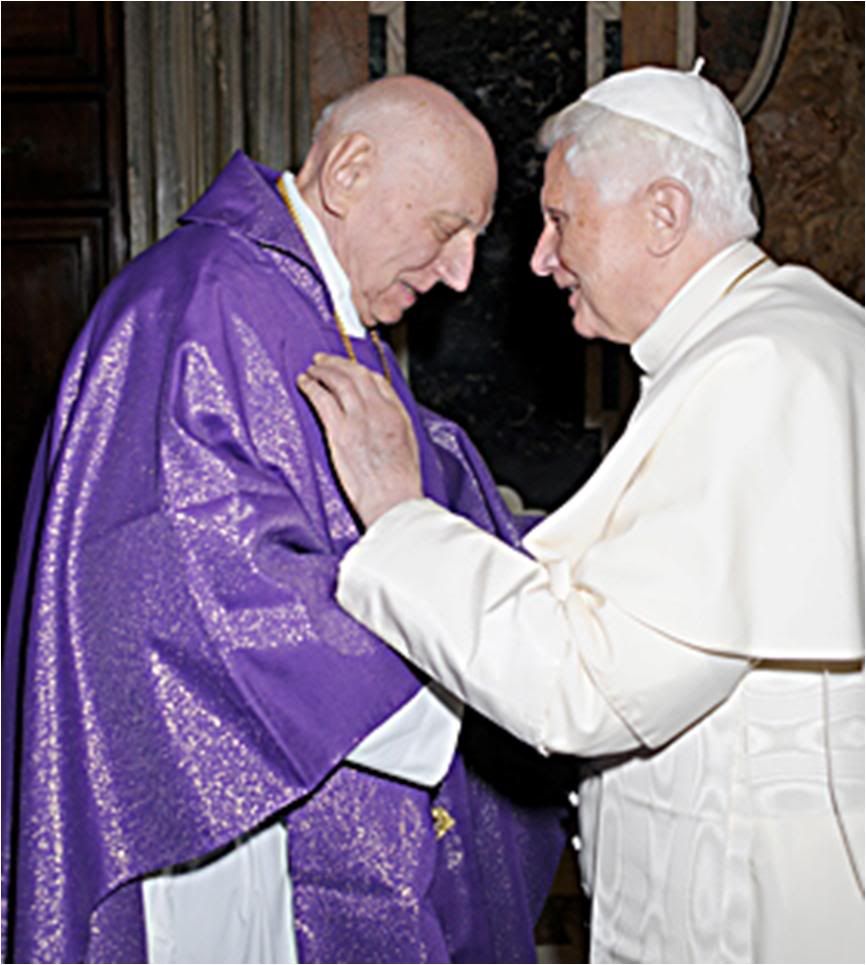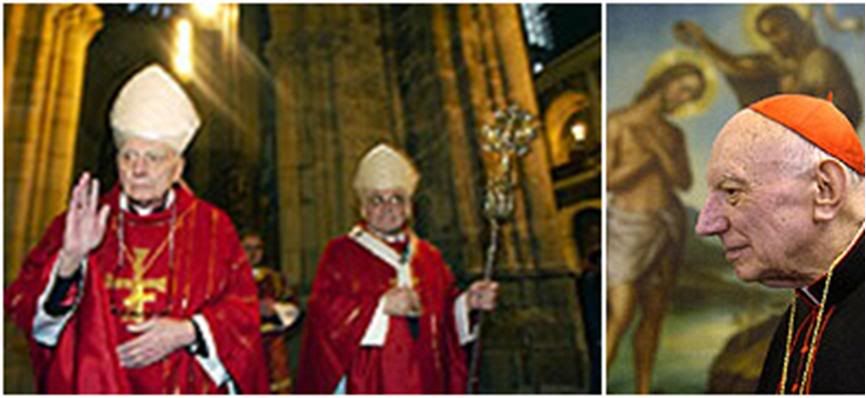| | | OFFLINE | | Post: 19.105
Post: 1.751 | Registrato il: 28/08/2005
Registrato il: 20/01/2009 | Administratore | Utente Veteran | |
|

 So many addresses by the Holy Father today, many of them requiring translation, so let me start with his first discourse today, a homily at an unusual Mass for an unusual occasion.
So many addresses by the Holy Father today, many of them requiring translation, so let me start with his first discourse today, a homily at an unusual Mass for an unusual occasion.
Benedict XVI's homilies are the papal texts I most look forward to and find most admirable - and I nurture the hope that someone in the Benedict XVI Foundation is going back over Joseph Ratzinger's enormous literary output to see if they can put together a homily by him for each day of the liturgical year.
 Pope says Mass for Cardinal Spidlik
Pope says Mass for Cardinal Spidlik
on his 90th birthday
Translated from

December 17, 2009
At 7:30 this morning, the Holy Father Benedict XVI presided at a Eucharistic Celebration with the community of the Centro Aletti in Rome in the Redemptoris Mater chapel of the Apostolic Palace, to mark the 90th birthday of Czech Cardinal Thomas Spidlik, S.J.
Here is a translation of the homily delivered by the Pope:
Dear friends,
With the liturgy today, we enter the last stage of the Advent journey, which calls us to intensify our preparation in order to celebrate the Nativity of the Lord with faith and joy, welcoming with intimate wonder God who has come to be with man, with each one of us.
The first reading presents us with the aged Jacob who calls together his sons to give them his blessing: it is an event of great intensity and emotion. This blessing is like a seal of faith on the covenant with God, but is also a prophetic vision that looks ahead and indicates a specific mission.
Jacob is the father who, through the not always linear paths of his personal story, has the joy of gathering his children around him and to trace the future of each of them and their descendancy.
In particular, today we heard the reference to the tribe of Judah, whose regal power is exalted, represented by the lion, as well as to the monarchy of David, represented by the scepter, staff of command, that alludes to the coming of the Messiah.
Thus what comes through in this double image, is the future mystery of the lion who becomes a lamb, the King whose staff of authority is the Cross, sign of true royalty.
Jacob had progressively become conscious of the primacy of God, he understood that his journey was led and sustained by the Lord's faithfulness, and he could only respond with full adherence to the covenant and design of God's salvation, becoming in turn, along with his own descendants, a link in the divine plan.
The Gospel passage from Matthew presents us with "the genealogy of Christ, son of David, son of Abraham" (Mt 1,1), underscoring and ultimately making explicit the faithfulness of God to his promise, which he is carrying out not only through men, but with them, and, as it was with Jacob, sometimes through tortuous and unforeseen ways.
The awaited Messiah, object of promise, is true God but also true man - Son of God, but also a child born of the Virgin, Mary of Nazareth, holy flesh descended from Abraham, in whose seed all the peoples of the earth would be blessed (cfr Gen 22,18).
In this genealogy, besides Mary, four other women are remembered - but not Sarah, Rebecca, Leah, or Rachel, the great women figures of Jewish history.
Paradoxically, they are four pagan women - Rahab, Ruth, Bathsheba, and Tamar - who seemingly 'spoil' the purity of the genealogy. But in these pagan women, who appear at decisive points in the history of salvation, the mystery of the church of the pagans emerges, the universality of salvation.
They are pagan women in whom the future appear, the universality of salvation. They are also sinners, and so, they also manifest the mystery of grace - it is not our works that redeem the world but the Lord who gives us true life.
They were sinners, yes, in whom appears the greatness of the grace that we are all in need of. These women nonetheless reveal exemplary responses to the faithfulness of God, by showing their faith in the God of Israel. That is how we see the church of the pagans emerge - mystery of grace, faith as gift and as a journey toward communion with God.
Thus the genealogy given by Matthew is not simply a list of generations: it is history as realized primarily by God but with mankind's response. It is a genealogy of grace and faith. The pursuit of the promise made by God to Israel rests on the absolute faithfulness of God to his promise, and on the solid faith of these women.
The blessing of Jacob comes happily on the 90th birthday today of our dear Cardinal Spidlik. His long life and singular journey of faith bear witness that God leads whoever entrusts himself to him.
But he has also followed a rich itinerary of thought, always communicating with ardor and profound conviction that the center of all Revelation is a Tri-Personal God, and that consequently, man who is created in his image is essentially a mystery of freedom and love realized in communion - which is the very way to' be of God'.
This communion does not exist by itself, but proceeds - as the Christian Orient does not tire of affirming - from the Divine Persons who love each other freely.
Freedom and love, constitutive elements of the person, cannot be grasped by means of rational categories - the person cannot be understood unless in terms of the mystery of Christ, true God and 'divine humanity' even in our own existence.
Faithful to this principle, Cardinal Spidlik has fashioned through the years a lively theological vision that is original in many aspects, in which the Christian East and West flow into each other organically, with a reciprocal exchange of their respective gifts.
His foundation is life in the Spirit; the principle of knowledge - love; study - an initiation into spiritual memory; concrete dialog with man - an indispensable criterion; and his context - the always living Body of Christ which is his Church.
Closely linked to this theological vision is the exercise of spiritual paternity, which Cardinal Spidlik has always carried out and continues to carry out.
Today, we can say that revolving around him in the celebration of the Divine Mysteries is his own 'small' spiritual descendancy, the Centro Aletti, which has accepted his precious teaching and made it fruitful through new institutions and new studies, and even through artistic representation.
In this context, I think it is particularly beautiful to underscore the link between theology and art in his thought. Indeed, it has been ten years since my venerated and beloved predecessor, the Servant of God John Paul II, dedicated this chapel, Redemptoris Mater, saying that "this work is offered as an expression of that theology with two lungs from which the Church of the Third Millennium may draw vitality".
He went on: "The image of the Redemptoris Mater - Mother of the Redeemer - which dominates the central wall places before our eyes the mystery of God's love who became man to give us, human beings, the capacity to become children of God... [It is] the message of salvation and joy that Christ, born of Mary, brought to mankind" (Insegnamenti XXII, 2 [1999], p. 895).
To you, dear Cardinal Spidlik, I wish from my heart the abundance of graces from the Lord, so you may continue to enlighten with your wisdom the members of the Centro Aletti and all your spiritual children.
Continuing with the celebration of the Holy Mysteries, I entrust each one to the maternal protection of the Mother of the Redeemer, invokingfrom the Divine Word who took on our flesh, the light and peace announced by the angels in Bethlehem. Amen.
Before the Pope's visit to thE Czech Republic last September, I posted two articles about Cardinal Spidlik in this thread and in the CZECH VISIT thread:
benedettoxviforum.freeforumzone.leonardo.it/discussione.aspx?idd=860...
 Above, left, recent photo of Cardinal Spidlik with Cardinal Vlk, Archbishop of Prague.
Above, left, recent photo of Cardinal Spidlik with Cardinal Vlk, Archbishop of Prague.
One of the outstanding personalities of the Church in the Czech Republic today is Cardinal Thomas Spidlik, botn in Brno 90 years ago. A Jesuit, he was forced to work in the quarries under both the Nazis and the Communists. He became a priest at age 30 despite difficulties of all kinds.
A world-famous theologian who became known for his books on tHE spirituality of thE Oriental Churches, he lives and works at the Centro Aletti in Rome with Fr. Marko Ivan Rupnik (artist of the mosaics in the Redemptoris Mater chapel and in the Padre Pio shrine in San Giovanni Rotondo).
For almost 50 years now, he has worked with Vatican Radio, dlivering a meditation every Friday. John Paul II MAde him a cardinal in 2003, when he was 83, uin recognition of his achievements as a theologian [like the late Avery Cardinal Dulles].
 More information about Cardinal Spidlik and his work can be found in:
www.sacredheart.edu/pages/24695_the_cardinal_spidlik_center_for_ecumenical_understan...
More information about Cardinal Spidlik and his work can be found in:
www.sacredheart.edu/pages/24695_the_cardinal_spidlik_center_for_ecumenical_understan...
[Modificato da TERESA BENEDETTA 17/12/2009 21:30] |